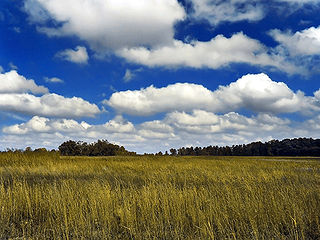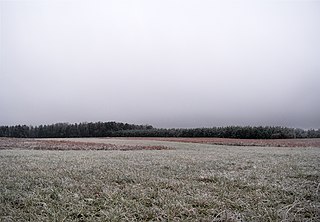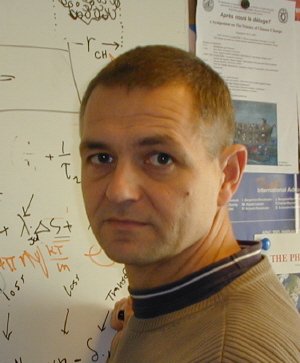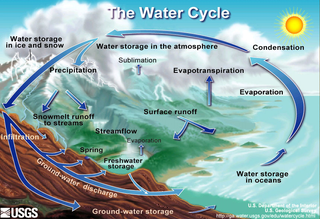Related Research Articles

The greenhouse effect occurs when greenhouse gases in a planet's atmosphere cause some of the heat radiated from the planet's surface to build up at the planet's surface. This process happens because stars emit shortwave radiation that passes through greenhouse gases, but planets emit longwave radiation that is partly absorbed by greenhouse gases. That difference reduces the rate at which a planet can cool off in response to being warmed by its host star. Adding to greenhouse gases further reduces the rate a planet emits radiation to space, raising its average surface temperature.

Climate variability includes all the variations in the climate that last longer than individual weather events, whereas the term climate change only refers to those variations that persist for a longer period of time, typically decades or more. Climate change may refer to any time in Earth's history, but the term is now commonly used to describe contemporary climate change. Since the Industrial Revolution, the climate has increasingly been affected by human activities.

Cloud albedo is a measure of the albedo or reflectivity of a cloud. Clouds regulate the amount of solar radiation absorbed by a planet and its solar surface irradiance. Generally, increased cloud cover correlates to a higher albedo and a lower absorption of solar energy. Cloud albedo strongly influences the Earth's energy budget, accounting for approximately half of Earth's albedo. Cloud albedo depends on the total mass of water, the size and shape of the droplets or particles and their distribution in space. Thick clouds reflect a large amount of incoming solar radiation, translating to a high albedo. Thin clouds tend to transmit more solar radiation and, therefore, have a low albedo. Changes in cloud albedo caused by variations in cloud properties have a significant effect on global climate.

In meteorology, a cloud is an aerosol consisting of a visible mass of miniature liquid droplets, frozen crystals, or other particles suspended in the atmosphere of a planetary body or similar space. Water or various other chemicals may compose the droplets and crystals. On Earth, clouds are formed as a result of saturation of the air when it is cooled to its dew point, or when it gains sufficient moisture from an adjacent source to raise the dew point to the ambient temperature.
Cloud feedback is the coupling between cloudiness and surface air temperature where a surface air temperature change leads to a change in clouds, which could then amplify or diminish the initial temperature perturbation. Cloud feedbacks can affect the magnitude of internally generated climate variability or they can affect the magnitude of climate change resulting from external radiative forcings.

Cumulus clouds are clouds that have flat bases and are often described as puffy, cotton-like, or fluffy in appearance. Their name derives from the Latin cumulus, meaning "heap" or "pile". Cumulus clouds are low-level clouds, generally less than 2,000 m (6,600 ft) in altitude unless they are the more vertical cumulus congestus form. Cumulus clouds may appear by themselves, in lines, or in clusters.

Altostratus is a middle-altitude cloud genus made up of water droplets, ice crystals, or a mixture of the two. Altostratus clouds are formed when large masses of warm, moist air rise, causing water vapor to condense. Altostratus clouds are usually gray or blueish featureless sheets, although some variants have wavy or banded bases. The sun can be seen through thinner altostratus clouds, but thicker layers can be quite opaque.

A stratocumulus cloud, occasionally called a cumulostratus, belongs to a genus-type of clouds characterized by large dark, rounded masses, usually in groups, lines, or waves, the individual elements being larger than those in altocumulus, and the whole being at a lower height, usually below 2,000 metres (6,600 ft). Weak convective currents create shallow cloud layers because of drier, stable air above preventing continued vertical development. Historically, in English, this type of cloud has been referred to as a twain cloud for being a combination of two types of clouds.

Stratus clouds are low-level clouds characterized by horizontal layering with a uniform base, as opposed to convective or cumuliform clouds formed by rising thermals. The term stratus describes flat, hazy, featureless clouds at low altitudes varying in color from dark gray to nearly white. The word stratus comes from the Latin prefix strato-, meaning "layer". Stratus clouds may produce a light drizzle or a small amount of snow. These clouds are essentially above-ground fog formed either through the lifting of morning fog or through cold air moving at low altitudes. Some call these clouds "high fog" for their fog-like form.

Cloud physics is the study of the physical processes that lead to the formation, growth and precipitation of atmospheric clouds. These aerosols are found in the troposphere, stratosphere, and mesosphere, which collectively make up the greatest part of the homosphere. Clouds consist of microscopic droplets of liquid water, tiny crystals of ice, or both, along with microscopic particles of dust, smoke, or other matter, known as condensation nuclei. Cloud droplets initially form by the condensation of water vapor onto condensation nuclei when the supersaturation of air exceeds a critical value according to Köhler theory. Cloud condensation nuclei are necessary for cloud droplets formation because of the Kelvin effect, which describes the change in saturation vapor pressure due to a curved surface. At small radii, the amount of supersaturation needed for condensation to occur is so large, that it does not happen naturally. Raoult's law describes how the vapor pressure is dependent on the amount of solute in a solution. At high concentrations, when the cloud droplets are small, the supersaturation required is smaller than without the presence of a nucleus.
This glossary of climate change is a list of definitions of terms and concepts relevant to climate change, global warming, and related topics.

Earth's energy budget accounts for the balance between the energy that Earth receives from the Sun and the energy the Earth loses back into outer space. Smaller energy sources, such as Earth's internal heat, are taken into consideration, but make a tiny contribution compared to solar energy. The energy budget also accounts for how energy moves through the climate system. Because the Sun heats the equatorial tropics more than the polar regions, received solar irradiance is unevenly distributed. As the energy seeks equilibrium across the planet, it drives interactions in Earth's climate system, i.e., Earth's water, ice, atmosphere, rocky crust, and all living things. The result is Earth's climate.
Climate engineering is a term used for both carbon dioxide removal and solar radiation management, also called solar geoengineering, when applied at a planetary scale. However, they have very different geophysical characteristics which is why the Intergovernmental Panel on Climate Change no longer uses this overarching term. Carbon dioxide removal approaches are part of climate change mitigation. Solar geoengineering involves reflecting some sunlight back to space. All forms of geoengineering are not a standalone solution to climate change, but need to be coupled with other forms of climate change mitigation. Another approach to geoengineering is to increase the Earth's thermal emittance through passive radiative cooling.

Henrik Svensmark is a physicist and professor in the Division of Solar System Physics at the Danish National Space Institute in Copenhagen. He is known for his work on the hypothesis that fewer cosmic rays are an indirect cause of global warming via cloud formation.

The CLAW hypothesis proposes a negative feedback loop that operates between ocean ecosystems and the Earth's climate. The hypothesis specifically proposes that particular phytoplankton that produce dimethyl sulfide are responsive to variations in climate forcing, and that these responses act to stabilise the temperature of the Earth's atmosphere. The CLAW hypothesis was originally proposed by Robert Jay Charlson, James Lovelock, Meinrat Andreae and Stephen G. Warren, and takes its acronym from the first letter of their surnames.
This is a list of climate change topics.

The Global Energy and Water Exchanges Project is an international research project and a core project of the World Climate Research Programme (WCRP).

Marine cloud brightening also known as marine cloud seeding and marine cloud engineering is a proposed solar radiation management climate engineering technique that would make clouds brighter, reflecting a small fraction of incoming sunlight back into space in order to offset anthropogenic global warming. Along with stratospheric aerosol injection, it is one of the two solar radiation management methods that may most feasibly have a substantial climate impact. The intention is that increasing the Earth's albedo, in combination with greenhouse gas emissions reduction, carbon dioxide removal, and adaptation, would reduce climate change and its risks to people and the environment. If implemented, the cooling effect is expected to be felt rapidly and to be reversible on fairly short time scales. However, technical barriers remain to large-scale marine cloud brightening. There are also risks with such modification of complex climate systems.

Climate change feedbacks are effects of global warming that amplify or diminish the effect of forces that initially cause the warming. Positive feedbacks enhance global warming while negative feedbacks weaken it. Feedbacks are important in the understanding of climate change because they play an important part in determining the sensitivity of the climate to warming forces. Climate forcings and feedbacks together determine how much and how fast the climate changes. Large positive feedbacks can lead to tipping points—abrupt or irreversible changes in the climate system—depending upon the rate and magnitude of the climate change.

Space mirrors are satellites that are designed to change the amount of solar radiation that impacts the Earth as a form of climate engineering. The concept was first theorised in 1923 by physicist Hermann Oberth and later developed in the 1980s by other scientists. Space mirrors can be used to increase or decrease the amount of solar energy that reaches a specific point of the earth for various purposes. They have been theorised as a method of solar geoengineering by creating a space sunshade to deflect sunlight and counter global warming.
References
- ↑ "13 VIDEOS". discovery.com. Discovery Channel . Retrieved August 23, 2016.
- ↑ "Discovery". Discovery. Archived from the original on 7 August 2012.
- ↑ Colin Dodds (12 August 2014). "Kevin O'Leary: Success Story". Toronto Star.